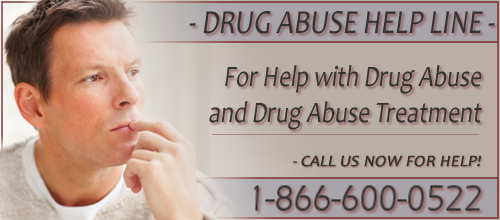About Drug Abuse
- Signs of Drug Abuse
- Causes of Drug Abuse
- Teen Drug Abuse
- Effects of Drug Abuse
- Prescription Drug Abuse
- Facts About Drug Abuse
- Drug Abuse Statistics
- Drug Abuse Counseling
- Drug Abuse Treatment
- Drug Abuse Information
- Preventing Drug Abuse
- Help for Drug Abuse
- Drug Abuse vs Drug Addiction
- Dangers of Drug Abuse
- Drug Abuse Recovery
- Drug Abuse in America

OxyContin Abuse
.png) Since the introduction of OxyContin in 1995, there has been a dramatic increase in OxyContin abuse. Unlike hydrocodone and its derivatives, whose potential for abuse is limited by the presence of aspirin/paracetamol, OxyContin contains only Oxycodone. The drug is easily abused by simply crushing the tablets and either ingestion by injection, inhalation or placed rectally. The drug can have serious side effects when injected as it has a prolonged extended action.
Since the introduction of OxyContin in 1995, there has been a dramatic increase in OxyContin abuse. Unlike hydrocodone and its derivatives, whose potential for abuse is limited by the presence of aspirin/paracetamol, OxyContin contains only Oxycodone. The drug is easily abused by simply crushing the tablets and either ingestion by injection, inhalation or placed rectally. The drug can have serious side effects when injected as it has a prolonged extended action.
Oxycodone is an opiate that is prescribed for moderate to high pain relief associated with severe injuries, bursitis, dislocation, fractures, neuralgia, arthritis, lower back and cancer pain. OxyContin, Perocet, Percodan, and Tylox are other trade names for Oxycodone products. Prescribed in tablet form, OxyContin is supposed to be taken orally to allow the controlled release of Oxycodone over a 12 hour period, making it the longest lasting pain reliever on the market. As with most opioids, Oxycodone is highly addictive and has a high potential for OxyContin abuse, thus it is classified by the Drug Enforcement Administration (DEA) as a Schedule II narcotic.
The drug is a powerful pain killer and widely used in clinical medicine. However, because of its mood altering effects, OxyContin, like morphine, can be abused and unlawful possession may be subject to criminal prosecution. Over the past decade, OxyContin has become a popular drug and its mood altering effects has led to a significant increase in usage.
Besides pain, OxyContin abuse can decrease anxiety, cause euphoria, mental relaxation, respiratory depression, constipation, meiosis (papillary constriction) and suppression of cough. Like all opioid analgesics, with increasing doses there is increasing pain relief. With OxyContin, like morphine, there is no definite maximum dose; the upper limit of pain control is controlled by side effects- the most dangerous of which is respiratory depression. The precise mechanism of OxyContin is unknown. However, it may interact with opioids receptors located in the brain and spinal cord.
OxyContin is a very powerful time released medication that is to be taken under close supervision of a physician. Using the drug without the supervision of a physician or for purposes other than its intended use can lead to serious and adverse consequences, including death from overdose. As mentioned above, when OxyContin abuse takes place tablets are crushed and snorted, chewed, injected or smoked. If the pill is not taken in the prescribed manner, the Oxycodone is introduced all at once rather than a slow release as intended. Within ten minutes, the effects are felt and last three to four hours. Most individuals with OxyContin abuse problems seek to gain euphoric effects, and avoid withdrawal symptoms associated with Oxycodone or heroin abstinence.
OxyContin is frequently made more available by "doctor shopping," where individuals, who do not have a legitimate illness, repeatedly visit many doctors to acquire large amounts of controlled substances. Other methods of obtaining OxyContin include pharmacy diversion, robbery, fake/stolen prescription, the internet and improper prescribing practices by physicians.
Side effects of OxyContin abuse include respiratory depression. Respiratory depression is a cause of concern in elderly or debilitated patients, and usually follows after the use of large initial doses in non tolerant patients, or when other opioids are given concurrently. Across the country, the majority of OxyContin abuse related deaths have occurred in individuals who were ingesting large quantities of OxyContin in combination with either alcohol or benzodiazepines. OxyContin should be used with extreme caution in patients with significant lung disorders such as chronic obstructive pulmonary disease, heart failure or pre-existing respiratory depression. In such patients, even usual therapeutic dose of OxyContin may suppress the respiratory drive to the point of arrest.
OxyContin Abuse / Prescription Drug Abuse Facts and Misconceptions:
- For the first time, there are just as many new abusers (12 and older) of prescription drugs as there are for marijuana.
- It is estimated that almost 30 million people used prescription drugs non-medically in 2009, and of those, 1.5 million were dependent on them.
- Prescription drugs have become the second most abused illegal drug behind marijuana in juveniles ages 12-17 and most commonly abused among 12-13 year olds.
- Society has developed the belief that "PILLS" cure all and if it's from the DRUG STORE, it must be SAFE and HARMLESS.
- Teens ages 12-17 have the second-highest annual rates of prescription drug abuse after young adults and are turning away from street drugs and using prescription drugs to get high.
- Teens feel using RX drugs to get high is "much safer" than street drugs, and because they are prescribed, 1/3 believe RX painkillers are not dangerous or addictive.
